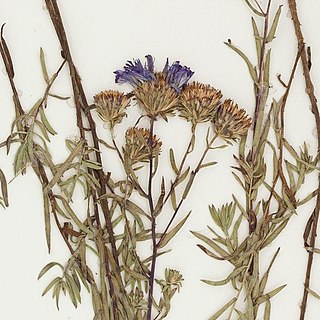
Symphyotrichum is a genus of over 100 species and naturally occurring hybrids of herbaceous annual and perennial plants in the composite family, Asteraceae, most which were formerly treated within the genus Aster. The majority are endemic to North America, but several also occur in the West Indies, Central and South America, as well as one species in eastern Eurasia. Several species have been introduced to Europe as garden specimens, most notably New England aster and New York aster.

Colubrina is a genus of about 30 species of flowering plants in the family Rhamnaceae, native to warm temperate to tropical regions of Africa, the Americas, southern Asia, northern Australia, and the Indian Ocean islands.
Keysseria (island-daisy) is a genus of flowering plants in the family Asteraceae. It includes 11 species, all of which are native to New Guinea with one species also native to northern Borneo.
Mexerion is a genus of flowering plants in the tribe Gnaphalieae within the family Asteraceae. As of May 2024, the number of species accepted varies from one to three.
Guy L. Nesom is an American writer and botanist.

Symphyotrichum dumosum is a species of flowering plant of the family Asteraceae commonly known as rice button aster and bushy aster. It is native to much of eastern and central North America, as well as Haiti and Dominican Republic. It is a perennial, herbaceous plant that may reach a height of 1 meter.

Eurybia kingii is a North American species of flowering plants in the family Asteraceae, called the King's serpentweed or King's aster. It has been found only in the State of Utah in the western United States.

Erythranthe, the monkey-flowers and musk-flowers, is a diverse plant genus with more than 120 members in the family Phrymaceae. Erythranthe was originally described as a separate genus, then generally regarded as a section within the genus Mimulus, and recently returned to generic rank. Mimulus sect. Diplacus was segregated from Mimulus as a separate genus at the same time. Mimulus remains as a small genus of eastern North America and the Southern Hemisphere. Molecular data show Erythranthe and Diplacus to be distinct evolutionary lines that are distinct from Mimulus as strictly defined, although this nomenclature is controversial.

Diplacus is a plant genus in the family Phrymaceae, which was traditionally placed in family Scrophulariaceae. In the 2012 restructuring of Mimulus by Barker, et al., based largely upon DNA evidence, seven species were left in Mimulus, 111 placed into Erythranthe, 46 placed into Diplacus, two placed in Uvedalia, and one each placed in Elacholoma, Mimetanthe, and Thyridia. Diplacus used to be a separate genus from Mimulus, but it was merged into Mimulus no later than 1905, until the 2012 restructuring. Dry and rocky areas are preferred.

Symphyotrichum patens, commonly known as late purple aster or spreading aster, is a perennial, herbaceous plant found in the eastern United States.
John Cameron Semple is a botanist, cytotaxonomist, professor emeritus, and adjunct professor at the University of Waterloo in Ontario, Canada. He was born in Boston and earned a degree of Bachelor of Science in 1969 from Tufts University, followed in 1971 and 1972 by Master of Arts and Doctor of Philosophy degrees from Washington University in St. Louis. Semple is known for his work with members of the tribe Astereae, particularly goldenrods, American asters, and goldenasters, and he maintains the University of Waterloo Astereae Lab website. Semple's wife is Brenda, and in 2013, he named a newly discovered goldenrod species Solidago brendiae in honor of her.

Sanrobertia is a genus of flowering plants within the subtribe Symphyotrichinae of the family Asteraceae. It is monotypic, meaning there is only one species within the genus. Sanrobertia gypsophila is a rare endemic known only from Nuevo León, Mexico.

Symphyotrichum hintonii is a species of perennial, herbaceous, flowering plant in the family Asteraceae native to Guerrero, Mexico. It grows in oak and oak-pine woods at elevations of 1,400–2,200 meters, blooming white ray florets November–January. It reaches heights of about 40–80 centimeters.

Symphyotrichum moranense is a species of flowering plant in the family Asteraceae. It is a perennial and herbaceous plant that reaches about 90 centimeters in height. Its white ray florets open October through April, and it is native to Mexico.

Symphyotrichum chihuahuense is a species of flowering plant in the family Asteraceae that is native to Chihuahua and Durango, Mexico. It is perennial and herbaceous and reaches heights of 20–35 centimeters. Its white ray florets open June–September, and it grows in grasslands and oak–pine woods at elevations 1,800–2,500 meters.

Symphyotrichum purpurascens is a species of flowering plant in the family Asteraceae native to areas of Mexico and Guatemala.

Symphyotrichum turneri is a species of flowering plant in the family Asteraceae native to Durango, Mexico.

Tiarella austrina is a species of flowering plant in the family Saxifragaceae. The specific name austrina means "from the south". Being endemic to the southeastern United States, it is sometimes referred to as the southern foamflower. It is one of two species of Tiarella that spread by stolons.

Helodeaster is a genus of flowering plants in the sunflower family, Asteraceae. It includes three species endemic to the Hawaiian Islands.















